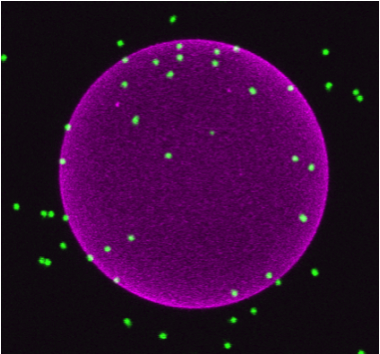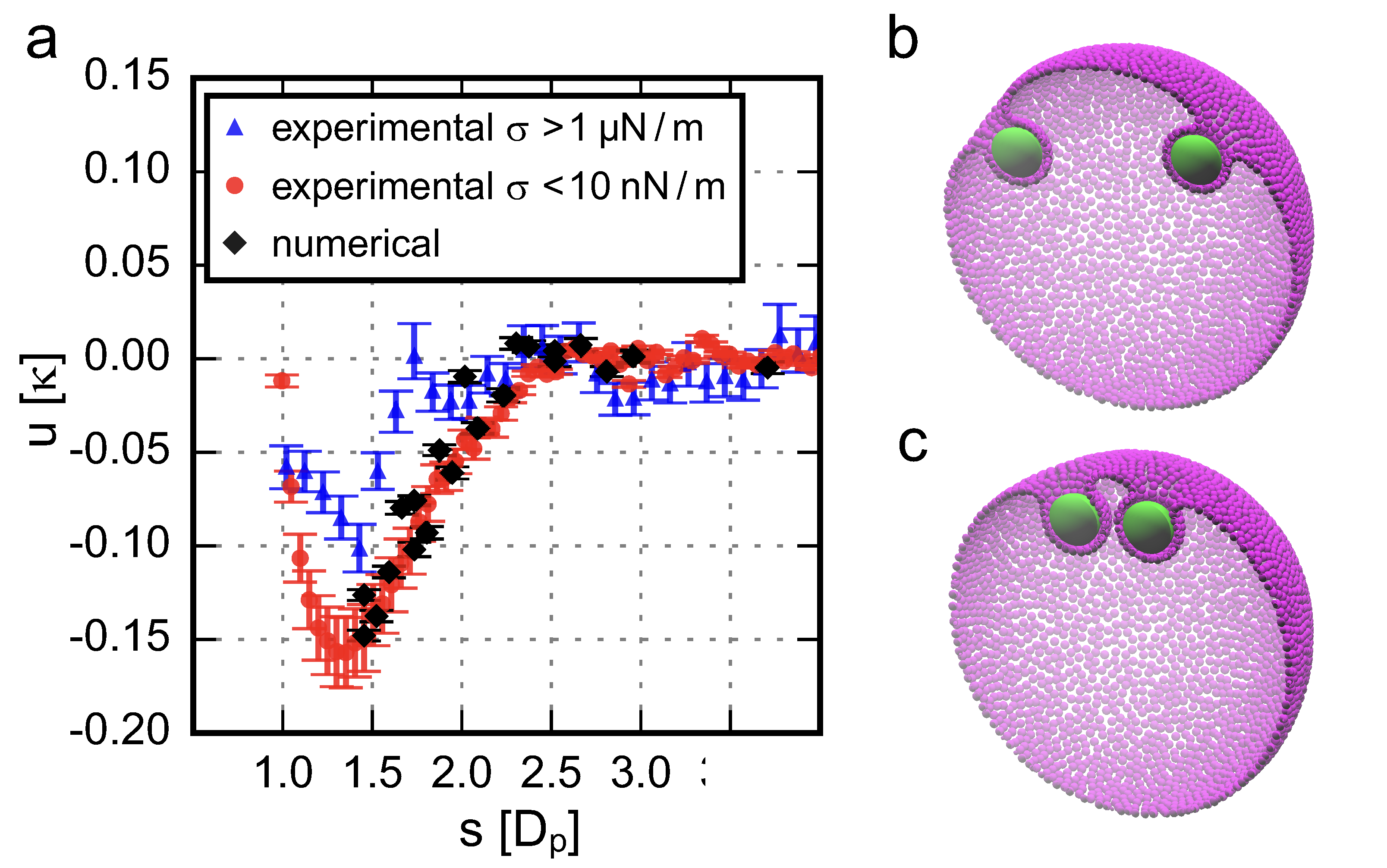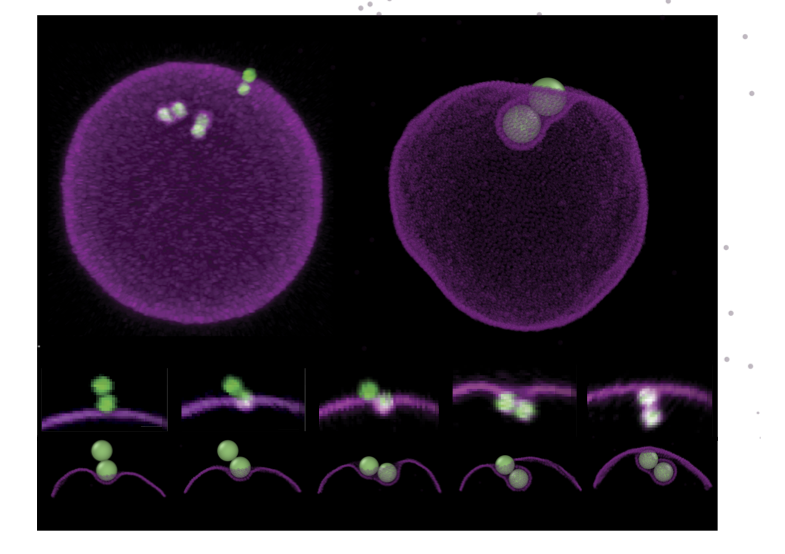Membrane-mediated interactions
Interactions stemming from lipid membrane deformations

Lipid membrane deforming objects, such as proteins, can interact through the membrane curvature they induce. These interactions have been predicted by theory and studied by simulations, however, the governing equations are highly involved and quantitative experiments are difficult due to the small size and complexity of proteins.
In the Kraft lab we therefore use a model system that consists of giant unilamellar vesicles and membrane-deforming colloidal particles to quantitatively study the interactions. Studying just two fully-wrapped colloidal spheres and carefully excluding other interactions, we could measure that the interaction induced by the membrane deformation is positive, a few kT strong (or about 0.1pN), and extends over a range of about 2 particle diameters.
For Janus spheres, i.e. particles which only adhere to the membrane with about half of their surface area thereby inducing much longer ranged deformations, we find much stronger attractions (up to about 0.4pN) at close distances, and small repulsions at slightly larger distances.

We complemented these observations by investigating the interactions between deformations pointing in opposite directions with respect to the membrane normal vector. This was experimentally realized by a particle deforming the membrane towards the inside of the GUV and pulling a membrane tube towards the outside of the membrane. Particles completely wrapped by the membrane are repelled, while particles that more strongly curve the membrane are attracted. This surprising behavior has been previously predicted by numerical calculations (Reynwar and Deserno, Soft matter, 2011).

Extrapolating from these measurements towards three interacting particles, however, is not straightforward as the interactions have been predicted to be non-additive. Measuring the interplay between three fully-wrapped spheres we found two preferred states: a linear arrangement and an equilateral triangle.
A mixture of wrapped and unwrapped particles follows a variety of assembly pathways on the membrane and leads to aggregates.
Publications
- C. van der Wel, A. Vahid, A. Šarić, T. Idema, D. Heinrich, D.J. Kraft, Lipid membrane-mediated attraction between curvature inducing objects, Scientific Reports, 6, 32825 (2016)
- C. van der Wel, D. Heinrich, D.J. Kraft, Microparticle assembly pathways on lipid membranes, Biophysical Journal, 113 (5), 1037-1046 (2017)
- A. Azadbakht, B. Meadowcroft, J. Majek, A. Saric, D.J. Kraft, Non-additivity in interactions between three membrane-wrapped colloidal spheres, Biophysical Journal, 123(3), 307-316 (2024)
- A. Azadbakht, D.J. Kraft, Repulsions and attractions between membrane-deforming spheres, Janus-particles, and opposite tube-like deformations in giant unilamellar vesicles, Soft Matter, 21, 4730-4738 (2025)
Interactions through lipid membrane deformations without adhesion

The adhesion required for membrane wrapping and thus deformation limits the experimental system to specific particles and the challenging imaging effectively restricts observations to a few particles only. To overcome these difficulties, we developed an alternative way to observe membrane deforming particles that do not require adhesion and can be observed in a large field of view. For that, we created sessile GUVs and pulled particles between the GUV and the substrate. As such, no adhesion was required to induce deformations and many (up to 36) particles could be observed at the same time. We found that at low particle numbers that the particles form highly ordered, compact clusters. With increasing numbers, however, they become gradually more disordered.
Publication
- A. Azadbakht, T. Weikl, D.J. Kraft, Non-additivity in many-body interactions between membrane-deforming spheres increases disorder, ACS Nano, 18/34, 23067–23076 (2024)
Lipid membrane wrapping

Endocytosis is a key cellular process involved in the uptake of nutrients, pathogens or the diagnosis and therapy of diseases. Most studies have focused on spherical objects, whereas biologically relevant shapes can be highly anisotropic. We used an experimental model system based on Giant Unilamellar Vesicles (GUVs) and dumbbell-shaped colloidal particles to mimic and investigate the first stage of the passive endocytic process: engulfment of an anisotropic object by the membrane. Our model has specific ligand-receptor interactions realized by mobile receptors on the vesicles and immobile ligands on the particles. Through a series of experiments, theory and molecular dynamics simulations, we quantify the wrapping process of anisotropic dumbbells by GUVs and identify distinct stages of the wrapping pathway. We find that the strong curvature variation in the neck of the dumbbell as well as membrane tension are crucial in determining both the speed of wrapping and the final states.
Publication
- A. Azadbakht, B. Meadowcroft, T. Varkevisser, A. Saric, D.J. Kraft, Wrapping pathways of anisotropic dumbbell particles by giant unilamellar vesicles, Nano Letters, 23(10), 4267-4273 (2023)